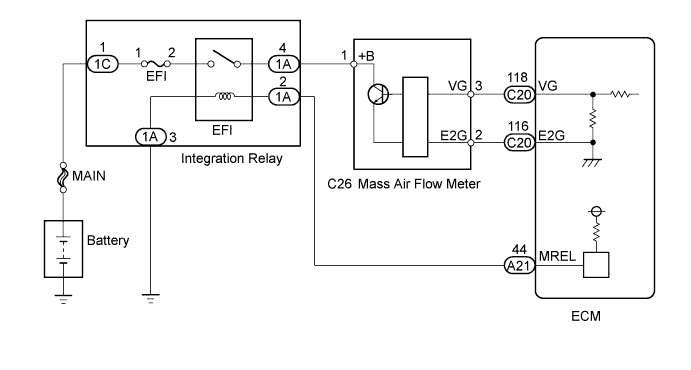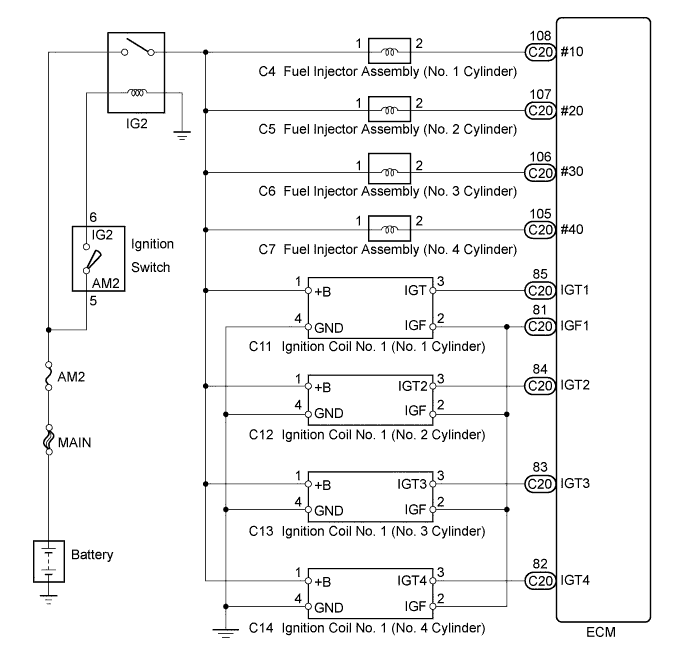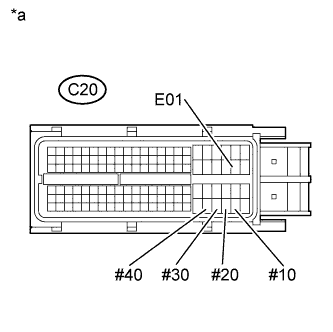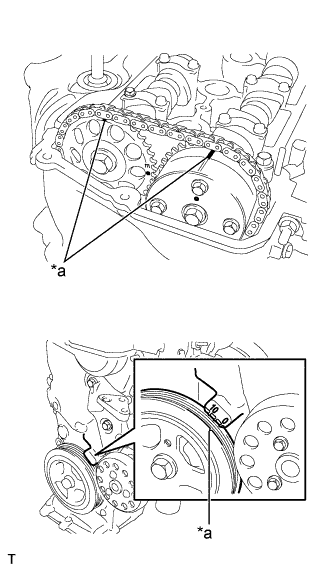DESCRIPTION
MONITOR DESCRIPTION
MONITOR STRATEGY
TYPICAL ENABLING CONDITIONS
TYPICAL MALFUNCTION THRESHOLDS
MONITOR RESULT
WIRING DIAGRAM
CONFIRMATION DRIVING PATTERN
INSPECTION PROCEDURE
CHECK ANY OTHER DTCS OUTPUT (IN ADDITION TO MISFIRE DTCS)
CHECK PCV HOSE CONNECTIONS
READ VALUE USING TECHSTREAM (MISFIRE RPM AND MISFIRE LOAD)
READ VALUE USING TECHSTREAM (CATALYST OT MF F/C)
PERFORM ACTIVE TEST USING TECHSTREAM (PROHIBIT CAT OT F/C)
READ VALUE USING TECHSTREAM (CYLINDER #1 MISFIRE COUNT, #2, #3 AND #4)
INSPECT SPARK PLUG
CHECK FOR SPARKS AND IGNITION
CHECK CYLINDER COMPRESSION PRESSURE OF MISFIRING CYLINDER
CHECK TERMINAL VOLTAGE (#10, #20, #30 AND/OR #40)
CHECK FUEL INJECTOR ASSEMBLY OF MISFIRING CYLINDER
CHECK INTAKE SYSTEM
CHECK FUEL PRESSURE
READ VALUE USING TECHSTREAM (COOLANT TEMP)
READ VALUE USING TECHSTREAM (MAF)
CHECK VALVE TIMING
CHECK INTAKE SYSTEM
CHECK FUEL PRESSURE
READ VALUE USING TECHSTREAM (COOLANT TEMP)
READ VALUE USING TECHSTREAM (MAF)
CHECK VALVE TIMING
INSPECT SPARK PLUG
CHECK FOR SPARKS AND IGNITION
CHECK CYLINDER COMPRESSION PRESSURE
CHECK TERMINAL VOLTAGE (#10, #20, #30 AND/OR #40)
CHECK FUEL INJECTOR ASSEMBLY OF MISFIRING CYLINDER
CHECK HARNESS AND CONNECTOR (MASS AIR FLOW METER CONNECTOR CONNECTION)
CHECK WHETHER DTC OUTPUT RECURS
CHECK HARNESS AND CONNECTOR (MASS AIR FLOW METER - ECM)
REPLACE MASS AIR FLOW METER
CONFIRM WHETHER MALFUNCTION HAS BEEN SUCCESSFULLY REPAIRED
CHANGE TO NORMAL SPARK PLUG AND CHECK SPARK OF MISFIRING CYLINDER
CHANGE TO NORMAL IGNITION COIL AND CHECK SPARK OF MISFIRING CYLINDER
CHECK FUEL LINE
DTC P0300 Random / Multiple Cylinder Misfire Detected |
DTC P0301 Cylinder 1 Misfire Detected |
DTC P0302 Cylinder 2 Misfire Detected |
DTC P0303 Cylinder 3 Misfire Detected |
DTC P0304 Cylinder 4 Misfire Detected |
DESCRIPTION
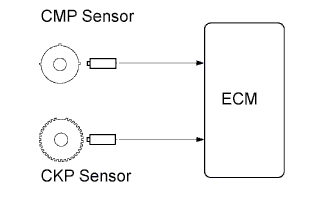 When the engine misfires, high concentrations of hydrocarbons (HC) enter the exhaust gas. Extremely high HC concentration levels can cause increases in exhaust emission levels. High concentrations of HC can also cause increases in the Three-Way Catalytic Converter (TWC) temperature, which may cause damage to the TWC. To prevent these increases in emissions and to limit the possibility of thermal damage, the ECM monitors the misfire rate. When the temperature of the TWC reaches the point of thermal degradation, the ECM blinks the MIL. To monitor misfires, the ECM uses both the Camshaft Position (CMP) sensor and the Crankshaft Position (CKP) sensor. The CMP sensor is used to identify any misfiring cylinders and the CKP sensor is used to measure variations in the crankshaft rotation speed. Misfires are counted as when the crankshaft rotation speed variations exceed predetermined thresholds. If the misfire rate exceeds the threshold level, and could cause emission deterioration, the ECM illuminates the MIL and stores a DTC.
When the engine misfires, high concentrations of hydrocarbons (HC) enter the exhaust gas. Extremely high HC concentration levels can cause increases in exhaust emission levels. High concentrations of HC can also cause increases in the Three-Way Catalytic Converter (TWC) temperature, which may cause damage to the TWC. To prevent these increases in emissions and to limit the possibility of thermal damage, the ECM monitors the misfire rate. When the temperature of the TWC reaches the point of thermal degradation, the ECM blinks the MIL. To monitor misfires, the ECM uses both the Camshaft Position (CMP) sensor and the Crankshaft Position (CKP) sensor. The CMP sensor is used to identify any misfiring cylinders and the CKP sensor is used to measure variations in the crankshaft rotation speed. Misfires are counted as when the crankshaft rotation speed variations exceed predetermined thresholds. If the misfire rate exceeds the threshold level, and could cause emission deterioration, the ECM illuminates the MIL and stores a DTC.DTC No.
| DTC Detection Condition
| Trouble Area
|
P0300
| Simultaneous misfiring of several cylinders detected
(2 trip detection logic)
| - Open or short in engine wire harness
- Connector connection
- Vacuum hose connections
- Ignition system
- Fuel injector assembly
- Fuel pressure
- Mass Air Flow (MAF) meter
- Engine Coolant Temperature (ECT) sensor
- Compression pressure
- Valve clearance
- Valve timing
- PCV valve and hose
- PCV hose connections
- Intake system
- ECM
|
P0301
P0302
P0303
P0304
| Misfiring of specific cylinder detected
(2 trip detection logic)
|
When DTCs for misfiring cylinders are randomly stored, but DTC P0300 is not stored, it indicates that misfires have been detected in different cylinders at different times. DTC P0300 is only stored when several misfiring cylinders are detected at the same time.
MONITOR DESCRIPTION
The ECM illuminates the MIL and stores a DTC when either one of the following conditions, which could cause emission deterioration, is detected (2 trip detection logic).- Within the first 1000 crankshaft revolutions of the engine starting, an excessive misfiring rate (approximately 20 to 50 misfires per 1000 crankshaft revolutions) occurs once.
- An excessive misfiring rate (approximately 20 to 50 misfires per 1000 crankshaft revolutions) occurs a total of 4 times.
The ECM flashes the MIL and stores a DTC when either one of the following conditions, which could cause the Three-Way Catalytic Converter (TWC) damage, is detected (2 trip detection logic).- HINT:
- If a catalyst damaged misfire occurs, the monitor informs the driver by blinking the MIL (1 trip).
- In every 200 crankshaft revolutions at a high engine rpm, the threshold misfiring percentage is recorded once.
- In every 200 crankshaft revolutions at a normal engine rpm, the threshold misfiring percentage is recorded 3 times.
- Misfire Monitor for Mexico Models
The ECM illuminates the MIL and stores a DTC when either one of the following conditions, which could cause emission deterioration, is detected (2 trip detection logic).
- Within the first 1000 crankshaft revolutions of the engine starting, an excessive misfiring rate (approximately 500 misfires per 1000 crankshaft revolutions) occurs once.
- An excessive misfiring rate (approximately 250 misfires per 1000 crankshaft revolutions) occurs a total of 4 times.
The ECM flashes the MIL and stores a DTC when the following condition, which could cause the Three-Way Catalytic Converter (TWC) damage, is detected (2 trip detection logic).
- A catalyst damaged misfire, which is monitored every 200 crankshaft revolutions, occurs 3 times.
MONITOR STRATEGY
Related DTCs
| P0300: Multiple cylinder misfire
P0301: Cylinder 1 misfire
P0302: Cylinder 2 misfire
P0303: Cylinder 3 misfire
P0304: Cylinder 4 misfire
|
Required Sensors/Components (Main)
| Crankshaft position sensor and Camshaft position sensor
|
Required Sensors/Components (Related)
| Engine coolant temperature and intake air temperature sensors and Mass air flow meter
|
Frequency of Operation
| Continuous
|
Duration
| 1000 crankshaft revolutions (soon after engine is started: 1 time, other 4 times) (Emissions-related misfire)
200 crankshaft revolutions (1 or 3 times) (Catalyst-damaging misfire)
|
MIL Operation
| 2 driving cycles: Emission-related misfire
MIL flashes immediately: Catalyst-damaged misfire
|
Sequence of Operation
| None
|
TYPICAL ENABLING CONDITIONS
Misfire:Monitor runs whenever following DTCs not present
| P0016 (VVT system - misalignment)
P0100, P0102,P0103 (MAF meter)
P0110, P0112, P0113 (IAT sensor)
P0115, P0117, P0118 (ECT sensor)
P0120 - P0123, P0220, P0222, P0223, P2135 (TP sensor)
P0125 (Insufficient ECT for Closed Loop)
P0327, P0328 (Knock sensor)
P0335 (CKP sensor)
P0340 (CMP sensor)
P0351 - P0354 (Igniter)
P0500 (VSS)
P0705 (Shift lever position switch)
|
Battery voltage
| 8 V or more
|
VVT system
| Not operated by scan tool
|
Engine RPM
| 450 to 6600 rpm
|
Either of following conditions (a) or (b) met
| -
|
(a) ECT at engine start
| More than -7°C (19°F)
|
(b) ECT
| More than 20°C (68°F)
|
Fuel cut
| OFF
|
Monitor period of emission-related misfire:First 1000 revolutions after engine start, or Check Mode
| Crankshaft 1000 revolutions
|
Except above
| Crankshaft 1000 revolutions x 4
|
Monitor period of catalyst-damaged misfire (MIL blinks):All of following conditions 1, 2 and 3 met
| Crankshaft 200 revolutions x 3
|
1. Driving cycles
| 1st
|
2. Check mode
| OFF
|
3. Engine RPM
| Less than 2800 rpm
|
Except above (MIL blinks immediately)
| Crankshaft 200 revolutions
|
- FOR MEXICO MODELS:
Misfire: for Mexico modelsMonitor runs whenever following DTCs not present
| P0016 (VVT system - misalignment)
P0102 - P0103 (MAF meter)
P0110 - P0113 (IAT sensor)
P0115 - P0118 (ECT sensor)
P0120 - P0223, P2135 (TP sensor)
P0125 (Insufficient ECT for Closed Loop)
P0327, P0328 (Knock sensor)
P0335 (CKP sensor)
P0340 (VVT sensor)
P0351 - P0354 (Igniter)
P0500 (VSS)
|
Battery voltage
| 8 V or more
|
VVT system
| Not operated by scan tool
|
Engine RPM
| 450 to 6600 rpm
|
ECT
| More than 65°C (149°F)
|
Fuel cut
| OFF
|
Monitor period of emission-related misfire: for Mexico modelsFirst 1000 revolutions after engine start, or Check Mode
| Crankshaft 1000 revolutions
|
Except above (MIL blinks immediately)
| Crankshaft 1000 revolutions x 4
|
Monitor period of catalyst-damaged misfire (MIL blinks): for Mexico modelsAll of following conditions 1, 2 and 3 met
| Crankshaft 200 revolutions x 3
|
1. Driving cycles
| 1st
|
2. Check mode
| OFF
|
Except above
| Crankshaft 200 revolutions
|
TYPICAL MALFUNCTION THRESHOLDS
Monitor period of emission-related misfire:Misfire rate
| 1.63% or more
|
Monitor period of catalyst-damage misfire (MIL blinks):Number of misfire per 200 revolutions
| 101 or more (varies with intake air amount and rpm)
|
- FOR MEXICO MODELS:
Monitor period of emission-related misfire: for Mexico modelsMisfire rate
| 50% or more: for 1st 1000 revolutions
25% or more: after 1st 1000 revolutions
|
Monitor period of catalyst-damaged misfire (MIL blinks): for Mexico modelsNumber of misfire per 200 revolutions
| 101 or more (varies with intake air amount and rpm)
|
MONITOR RESULT
Refer to Checking Monitor Status (YARIS_NCP93 RM000000PDR0A3X.html).
WIRING DIAGRAM
CONFIRMATION DRIVING PATTERN
- Connect the Techstream to the DLC3.
- Turn the ignition switch to ON.
- Turn the Techstream on.
- Record the DTC(s) and freeze frame data.
- Clear DTCs (even if no DTCs are stored, perform the clear DTC operation) (YARIS_NCP93 RM000000PDK0QGX.html).
- Using the Techstream, switch the ECM from normal mode to check mode (YARIS_NCP93 RM000000PDL0J3X.html).
- Read the misfire counts of each cylinder, Cylinder #1 Misfire Count to Cylinder #4 Misfire Count, with the engine in an idling condition. If any misfire count is displayed, skip the following confirmation driving pattern.
- Drive the vehicle several times with the conditions, such as engine rpm and engine load, shown in Misfire RPM and Misfire Load in the Data List.
- HINT:
- In order to store misfire DTCs, it is necessary to operate the vehicle for the period of time shown in the table below, using the Misfire RPM and Misfire Load in the Data List.
Engine RPM
| Duration
|
Idling
| 7.0 minutes or more
|
1000
| 4.0 minutes or more
|
2000
| 2.0 minutes or more
|
3000
| 1.5 minutes or more
|
- Check whether misfires have occurred by checking DTCs and freeze frame data.
- HINT:
- Do not turn the ignition switch off until the stored DTC(s) and freeze frame data have been recorded. When the ECM returns to normal mode (default), the stored DTC(s), freeze frame data and other data will be erased.
- Record the DTC(s), freeze frame data and misfire counts.
- Turn the ignition switch off and wait for at least 30 seconds.
- Clear DTCs (even if no DTCs are stored, perform the clear DTC operation).
INSPECTION PROCEDURE
- NOTICE:
- Inspect the fuses for circuits related to this system before performing the following inspection procedure.
- HINT:
- If any DTCs other than misfire DTCs are output, troubleshoot those DTCs first.
- Read freeze frame data using the Techstream. The ECM records vehicle and driving condition information as freeze frame data the moment a DTC is stored. When troubleshooting, freeze frame data can help determine if the vehicle was moving or stationary, if the engine was warmed up or not, if the air fuel ratio was lean or rich, and other data from the time the malfunction occurred.
- If the misfire does not recur when the vehicle is brought to the workshop, reproduce the conditions stored in the ECM as freeze frame data.
- If the misfire still cannot be reproduced even though the conditions stored in the ECM as freeze frame data have been reproduced, the following factors are possible causes of the problem:
- There is insufficient fuel in the tank.
- Improper fuel is used.
- The spark plugs are contaminated.
- The problem requires further diagnosis.
- After finishing repairs, check the misfire counts of the cylinders Cylinder #1 Misfire Count to Cylinder #4 Misfire Count.
- Be sure to confirm that no misfiring cylinder DTCs are stored again by conducting the confirmation driving pattern after finishing repairs.
- When one of Short FT #1, Long FT #1, Short FT #2 or Long FT #2 in the freeze frame data is outside the range of +/-20%, the air-fuel ratio may be Rich (-20% or less) or Lean (+20% or more).
- When the Coolant Temp in the freeze frame data is less than 75°C (167°F), the misfires have occurred only while warming up the engine.
- An extremely imbalanced drive wheel which causes body vibration may cause misfire DTCs to be stored.
| 1.CHECK ANY OTHER DTCS OUTPUT (IN ADDITION TO MISFIRE DTCS) |
Connect the Techstream to the DLC3.
Turn the ignition switch to ON.
Turn the Techstream on.
Enter the following menus: Powertrain / Engine and ECT / Trouble Codes.
Read DTCs.
ResultResult
| Proceed to
|
DTC P0300, P0301, P0302, P0303 and/or P0304 are output
| A
|
DTC P0300, P0301, P0302, P0303 and/or P0304 and other DTCs are output
| B
|
- HINT:
- If any DTCs other than P0300, P0301, P0302, P0303 and P0304 are output, troubleshoot those DTCs first.
| 2.CHECK PCV HOSE CONNECTIONS |
Check the PCV hose connection (YARIS_NCP93 RM000001L6B007X.html).
- OK:
- PCV valve and hose are connected correctly and are not damaged.
| | REPAIR OR REPLACE PCV HOSE |
|
|
| 3.READ VALUE USING TECHSTREAM (MISFIRE RPM AND MISFIRE LOAD) |
Connect the Techstream to the DLC3.
Turn the ignition switch to ON.
Turn the Techstream on.
Enter the following menus: Powertrain / Engine and ECT / Data List / Misfire RPM and Misfire Load.
Read and note the Misfire RPM and Misfire Load values.
- HINT:
- The Misfire RPM and Misfire Load values indicate the vehicle conditions under which the misfire occurred.
| 4.READ VALUE USING TECHSTREAM (CATALYST OT MF F/C) |
Connect the Techstream to the DLC3.
Turn the ignition switch to ON.
Turn the Techstream on.
Enter the following menus: Powertrain / Engine and ECT / Data List / Catalyst OT MF F/C.
Read the value displayed on the Techstream.
ResultData List
| Techstream Display
| Proceed to
|
Catalyst OT MF F/C
| Avail
| A
|
Not Avl
| B
|
| 5.PERFORM ACTIVE TEST USING TECHSTREAM (PROHIBIT CAT OT F/C) |
Connect the Techstream to the DLC3.
Turn the ignition switch to ON.
Turn the Techstream on.
Enter the following menus: Powertrain / Engine and ECT / Active Test / Prohibit the Catalyst OT Misfire prevent F/C.
Perform the Active Test.
- NOTICE:
- When performing the Active Test, make sure the vehicle is stopped and either idling or being revved within 3000 rpm.
| 6.READ VALUE USING TECHSTREAM (CYLINDER #1 MISFIRE COUNT, #2, #3 AND #4) |
Enter the following menus: Powertrain / Engine / Data List / Cylinder #1 Misfire Count, Cylinder #2 Misfire Count, Cylinder #3 Misfire Count and Cylinder #4 Misfire Count.
Start the engine and allow the engine to idle.
Read each value for Cylinder #1 Misfire Count to Cylinder #4 Misfire Count displayed on the Techstream. If no misfire counts occur in any cylinders, perform following steps and then check the misfire counts again.
Drive the vehicle with the Misfire RPM and Misfire Load noted in the "Read Value Using Techstream (Misfire RPM and Misfire Load)" procedures above.
Read the Cylinder #1 Misfire Count to Cylinder #4 Misfire Count or DTCs displayed on the Techstream.
ResultResult
| Proceed To
|
Most misfires occur in only 1 or 2 cylinders
| A
|
3 cylinders or more have equal misfire counts
| B
|
- HINT:
- If it is difficult to reproduce misfires for each cylinder, check the Data List item called Misfire Margin. Try to find vehicle driving conditions that lower the Misfire Margin value. Values above 30% are considered normal.
- If the freeze frame data's record of the ECT is below 75°C (167°F), the misfire may be detected only when the engine is cold.
- If the freeze frame data's record of the Engine Run Time is below 120 seconds, the misfire may be detected immediately after the engine is started.
Inspect the spark plug of the misfiring cylinder (YARIS_NCP93 RM000001EFG05DX_01_0002.html).
| 8.CHECK FOR SPARKS AND IGNITION |
Perform a spark test (YARIS_NCP93 RM000001EFG05DX_01_0001.html).
| 9.CHECK CYLINDER COMPRESSION PRESSURE OF MISFIRING CYLINDER |
Measure the cylinder compression pressure of the misfiring cylinder (YARIS_NCP93 RM000001DCF01KX_01_0008.html).
| | CHECK ENGINE TO DETERMINE CAUSE OF LOW COMPRESSION |
|
|
| 10.CHECK TERMINAL VOLTAGE (#10, #20, #30 AND/OR #40) |
Disconnect the ECM connector.
Turn the ignition switch to ON.
Measure the voltage between the terminals of the ECM connector.
- Standard voltage:
Tester Connection
| Switch Condition
| Specified Condition
|
#10 (C20-108) - E01 (C20-45)
| Ignition Switch ON
| 11 to 14 V
|
#20 (C20-107) - E01 (C20-45)
| Ignition Switch ON
| 11 to 14 V
|
#30 (C20-106) - E01 (C20-45)
| Ignition Switch ON
| 11 to 14 V
|
#40 (C20-105) - E01 (C20-45)
| Ignition Switch ON
| 11 to 14 V
|
Text in Illustration*a
| Front view of wire harness connector
(to ECM)
|
Reconnect the ECM connector.
| 11.CHECK FUEL INJECTOR ASSEMBLY OF MISFIRING CYLINDER |
Check the injector injection (whether fuel volume is high or low, and whether injection pattern is poor) (YARIS_NCP93 RM000001EDQ046X.html).
Check the intake system for vacuum leak.
- OK:
- No leak from intake system.
| | REPAIR OR REPLACE INTAKE SYSTEM |
|
|
Check the fuel pressure (YARIS_NCP93 RM000001EF100YX_01_0002.html).
| 14.READ VALUE USING TECHSTREAM (COOLANT TEMP) |
Connect the Techstream to the DLC3.
Turn the ignition switch to ON.
Turn the Techstream on.
Enter the following menus: Powertrain / Engine and ECT / Data List / Coolant Temp.
Read the Data List twice, when the engine is both cold and warmed up.
- Standard:
Techstream Display
| Condition
| Specified Condition
|
Coolant Temp
| Cold engine
| Same as ambient air temperature
|
Warm engine
| Between 80 and 100°C (176 and 212°F)
|
| 15.READ VALUE USING TECHSTREAM (MAF) |
Connect the Techstream to the DLC3.
Turn the ignition switch to ON.
Turn the Techstream on.
Enter the following menus: Powertrain / Engine and ECT / Data List / MAF, Coolant Temp and Engine Speed.
Allow the engine to idle until Coolant Temp reaches 75°C (167°F) or higher.
Read MAF with the engine speed at 2500 rpm.
- Standard:
Techstream Display
| Condition
| Specified Condition
|
MAF
| Shift lever position: N
A/C: Off
Engine Speed: 2500 rpm
| Between 2 gm/sec, and 6 gm/sec.
|
Remove the cylinder head cover.
Turn the crankshaft pulley, and align its groove with the timing mark "0" on the timing chain cover.
Check that the timing marks on the camshaft timing sprocket and camshaft timing gear are facing upward as shown in the illustration.
- If not, turn the crankshaft 1 revolution (360°), then align the marks as above.
- OK:
- Timing marks on camshaft timing gears are aligned as shown in the illustration.
Text in Illustration*a
| Timing Mark
|
Reinstall the cylinder head cover.
Check the intake system for vacuum leak.
- OK:
- No leak from intake system.
| | REPAIR OR REPLACE INTAKE SYSTEM |
|
|
Check the fuel pressure (YARIS_NCP93 RM000001EF100YX_01_0002.html).
| 19.READ VALUE USING TECHSTREAM (COOLANT TEMP) |
Connect the Techstream to the DLC3.
Turn the ignition switch to ON.
Turn the Techstream on.
Enter the following menus: Powertrain / Engine and ECT / Data List / Coolant Temp.
Read the Data List twice, when the engine is both cold and warmed up.
- Standard:
Techstream Display
| Condition
| Specified Condition
|
Coolant Temp
| Cold engine
| Same as ambient air temperature
|
Warm engine
| Between 80 and 100°C (176 and 212°F)
|
| 20.READ VALUE USING TECHSTREAM (MAF) |
Connect the Techstream to the DLC3.
Turn the ignition switch to ON.
Turn the Techstream on.
Enter the following menus: Powertrain / Engine and ECT / Data List / MAF, Coolant Temp and Engine Speed.
Allow the engine to idle until Coolant Temp reaches 75°C (167°F) or higher.
Read MAF with the engine speed at 2500 rpm.
- Standard:
Techstream Display
| Condition
| Specified Condition
|
MAF
| Shift lever position: N
A/C: Off
Engine Speed: 2500 rpm
| Between 2 gm/sec, and 6 gm/sec.
|
Remove the cylinder head cover.
Turn the crankshaft pulley, and align its groove with the timing mark "0" on the timing chain cover.
Check that the timing marks on the camshaft timing sprocket and camshaft timing gear are facing upward as shown in the illustration.
- If not, turn the crankshaft 1 revolution (360°), then align the marks as above.
- OK:
- Timing marks on camshaft timing gears are aligned as shown in the illustration.
Text in Illustration*a
| Timing Mark
|
Reinstall the cylinder head cover.
Inspect the spark plug of the misfiring cylinder (YARIS_NCP93 RM000001EFG05DX_01_0002.html).
| 23.CHECK FOR SPARKS AND IGNITION |
Perform a spark test (YARIS_NCP93 RM000001EFG05DX_01_0001.html).
| 24.CHECK CYLINDER COMPRESSION PRESSURE |
Measure the cylinder compression pressure of the misfiring cylinder (YARIS_NCP93 RM000001DCF01KX_01_0008.html).
| | CHECK ENGINE TO DETERMINE CAUSE OF LOW COMPRESSION |
|
|
| 25.CHECK TERMINAL VOLTAGE (#10, #20, #30 AND/OR #40) |
Disconnect the ECM connector.
Turn the ignition switch to ON.
Measure the voltage between the terminals of the ECM connector.
- Standard voltage:
Tester Connection
| Switch Condition
| Specified Condition
|
#10 (C20-108) - E01 (C20-45)
| Ignition Switch ON
| 11 to 14 V
|
#20 (C20-107) - E01 (C20-45)
| Ignition Switch ON
| 11 to 14 V
|
#30 (C20-106) - E01 (C20-45)
| Ignition Switch ON
| 11 to 14 V
|
#40 (C20-105) - E01 (C20-45)
| Ignition Switch ON
| 11 to 14 V
|
Text in Illustration*a
| Front view of wire harness connector
(to ECM)
|
Reconnect the ECM connector.
| 26.CHECK FUEL INJECTOR ASSEMBLY OF MISFIRING CYLINDER |
Check the injector injection (whether fuel volume is high or low, and whether injection pattern is poor) (YARIS_NCP93 RM000001EDQ046X.html).
| 27.CHECK HARNESS AND CONNECTOR (MASS AIR FLOW METER CONNECTOR CONNECTION) |
Check the connection and terminal contact pressure of connectors and wire harnesses between the mass air flow meter and ECM (YARIS_NCP93 RM000000UZ309WX.html).
- HINT:
- Repair any problems.
| 28.CHECK WHETHER DTC OUTPUT RECURS |
Connect the Techstream to the DLC3.
Turn the ignition switch to ON.
Turn the Techstream on.
Clear DTCs (YARIS_NCP93 RM000000PDK0QGX.html).
Turn the ignition switch off and wait for at least 30 seconds.
Turn the ignition switch to ON.
Turn the Techstream on.
Start the engine.
Warm up the engine.
Drive the vehicle in accordance with the driving pattern described in Confirmation Driving Pattern.
Enter the following menus: Powertrain / Engine and ECT / Utility / All Readiness.
Input the DTC: P0300, P0301, P0302, P0303 or P0304.
Check the DTC judgment result.
ResultResult
| Proceed to
|
ABNORMAL (P0300, P0301, P0302, P0303 or P0304 output)
| A
|
NORMAL (No DTC output)
| B
|
| 29.CHECK HARNESS AND CONNECTOR (MASS AIR FLOW METER - ECM) |
Disconnect the mass air flow meter connector.
Disconnect the ECM connector.
Measure the resistance according to the value(s) in the table below.
- Standard Resistance (Check for Open):
Tester Connection
| Condition
| Specified Condition
|
C26-3 (VG) - C20-118 (VG)
| Always
| Below 1 Ω
|
C26-2 (E2G) - C20-116 (E2G)
|
- Standard Resistance (Check for Short):
Tester Connection
| Condition
| Specified Condition
|
C26-3 (VG) or C20-118 (VG) - Body ground
| Always
| 10 kΩ or higher
|
Reconnect the mass air flow meter connector.
Reconnect the ECM connector.
| | REPAIR OR REPLACE HARNESS OR CONNECTOR |
|
|
| 30.REPLACE MASS AIR FLOW METER |
Replace the mass air flow meter (YARIS_NCP93 RM000001D0L00WX.html).
- HINT:
- If the results of the inspections performed in steps 15 and 20 indicated no problem, proceed to the next step without replacing the mass air flow meter.
| 31.CONFIRM WHETHER MALFUNCTION HAS BEEN SUCCESSFULLY REPAIRED |
Connect the Techstream to the DLC3.
Turn the ignition switch to ON.
Turn the Techstream on.
Clear DTCs (YARIS_NCP93 RM000000PDK0QGX.html).
Turn the ignition switch off and wait for at least 30 seconds.
Turn the ignition switch to ON.
Turn the Techstream on.
Start the engine.
Warm up the engine.
Drive the vehicle in accordance with the driving pattern described in Confirmation Driving Pattern.
Enter the following menus: Powertrain / Engine and ECT / Utility / All Readiness.
Input the DTC: P0300, P0301, P0302, P0303 or P0304.
Check the DTC judgment result.
ResultResult
| Proceed to
|
NORMAL (No DTC output)
| A
|
ABNORMAL (P0300, P0301, P0302, P0303 or P0304 output)
| B
|
| 32.CHANGE TO NORMAL SPARK PLUG AND CHECK SPARK OF MISFIRING CYLINDER |
Change the installed spark plug to a spark plug that functions normally.
Perform a spark test.
- CAUTION:
- Always disconnect all fuel injector connectors.
- NOTICE:
- Do not crank the engine for more than 2 seconds.
Install the spark plug into the ignition coil No. 1 and connect the ignition coil connector.
Disconnect the fuel injector connector.
Ground the spark plug.
Check if sparks occur while the engine is being cranked.
- OK:
- Sparks jump across electrode gap.
| 33.CHANGE TO NORMAL IGNITION COIL AND CHECK SPARK OF MISFIRING CYLINDER |
Change the ignition coil No. 1 to an ignition coil No. 1 that functions normally.
Perform a spark test.
- CAUTION:
- Always disconnect all fuel injector connectors.
- NOTICE:
- Do not crank the engine for more than 2 seconds.
Install the spark plug into the ignition coil No. 1 and connect the ignition coil connector.
Disconnect the fuel injector connector.
Ground the spark plug.
Check if sparks occur while the engine is being cranked.
- OK:
- Sparks jump across electrode gap.
Check the fuel lines for leaks or blockage.
| | REPAIR OR REPLACE FUEL LINE |
|
|

